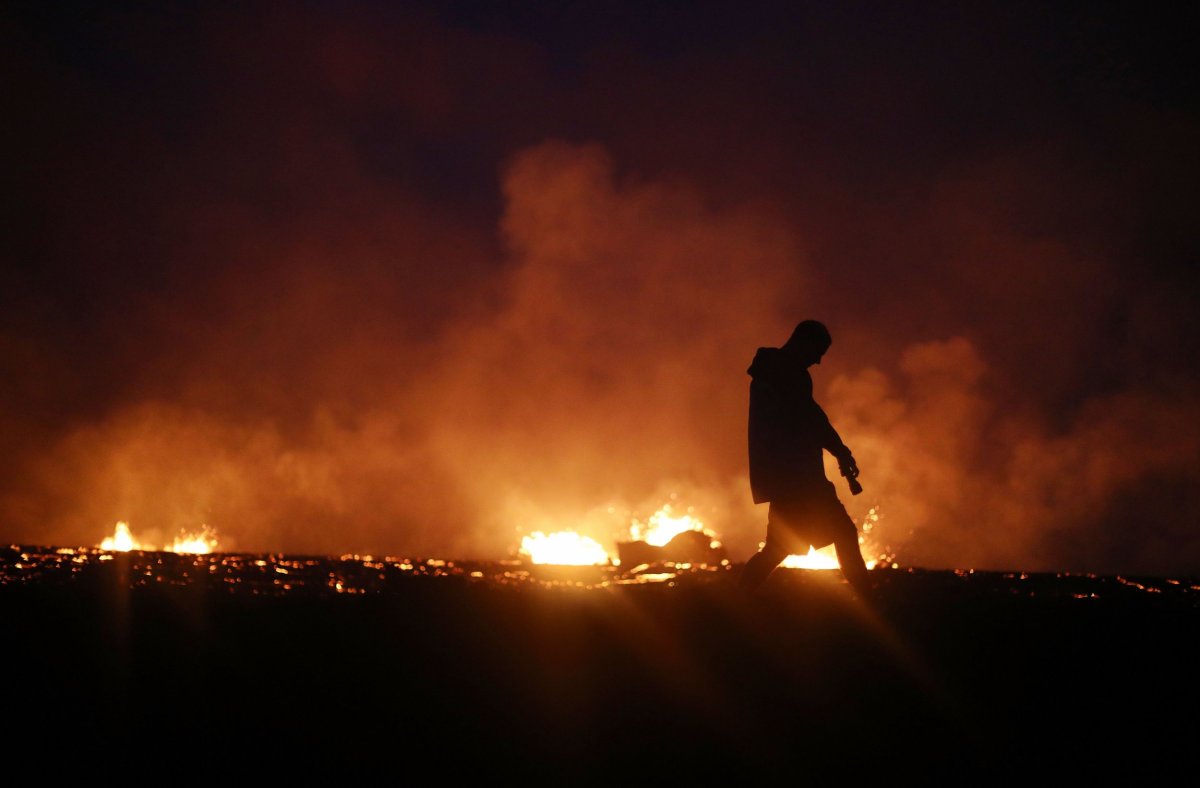As eruptions continue at Hawaii's Kīlauea volcano, several more properties have been destroyed by flowing streams of lava, with authorities urging residents to flee.
The lava flows occurred in the district of Puna—to the east of the volcano's summit on Hawaii's Big Island—affecting the Leilani Estates subdivision and Lanipuna Gardens, according to the state's Civil Defense agency.
The total number of buildings destroyed by the latest series of eruptions, which began on May 3, has now risen from 50 to 82, Reuters reports.
Over recent weeks, a number of fissures have opened up on the eastern flank of the volcano, releasing toxic gases and streams of lava which have forced the evacuation of around 2,000 people. Around 2,200 acres of land have been covered in lava, and flows have also reached the ocean.
Two of these fissures are feeding a pond of lava which is producing a slow-moving flow that has crossed Kahukai Street and is travelling east towards Mohala Street. It has already consumed a number of houses on Kaupuli Street.
"Any residents remaining in the currently affected areas should evacuate now," Hawaii County Civil Defense said in an alert. The Hawaii County Fire Department has been knocking door-to-door in these streets to see if residents needed assistance.
Meanwhile, the U.S. Geological Survey (USGS) is warning citizens across the whole of Puna District to stay informed and heed the Civil Defense Agency's closures, warnings and messages.
These lava flows could threaten Highway 132, according to the Honolulu Star Advertiser, an important access road for authorities and an evacuation route for residents.
US Marines stationed in Hawaii are now on standby to help with evacuations should they be needed, Big Island Video News reports.
Meanwhile, the USGS reports that toxic volcanic gas emissions have tripled as a result of eruptions from the fissures. This could lead to a phenomenon known as "vog" in areas downwind of the vents.
Vog is a combination of water, carbon dioxide, sulfur dioxide, dust and fine particles, which can cause irritation to the lungs, especially in people who suffer from respiratory problems.
Latest Photos of Hawaii's Kilauea Volcano Eruption: Residents Flee as Lava Advances Towards Homes
The USGS is also warning that areas where lava meets the ocean are hazardous.
"Hazards include walking on uneven, glassy lava flow surfaces and around unstable, vertical sea cliffs," the agency said in an alert. "Venturing too close to an ocean entry on land or the ocean exposes you to flying debris from the sudden explosive interaction between lava and water."
"Also, the lava delta is unstable because it is built on unconsolidated lava fragments and sand. This loose material can easily be eroded away by surf, causing the new land to become unsupported and slide into the sea."

Furthermore, the interaction of lava and the sea can create a potentially dangerous phenomenon known as "laze" or lava haze—a combination of toxic hydrochloric acid fumes, steam and fine volcanic glass-like particles.
In addition to activity on the eastern flanks of the volcano, a number of small earthquakes and eruptions also occurred at the summit over the course of Friday, with ash being ejected ash up to 12,000 feet into the air. The largest of these earthquakes measured 4.4 on the Richter scale, although no tsunami warning has been issued, according to the USGS.
Kīlauea—which rises 4,190 feet above Hawaii's Big Island, making up around 14 percent of its total area—is one of the world's most active volcanoes. It has been erupting on a continuous basis since 1983.
Experts cannot say for sure when the latest spike in its activity will die down, but officials have stressed that the effects are localized to a roughly 10-square-mile area on the south-eastern coast of the Big Island.
Uncommon Knowledge
Newsweek is committed to challenging conventional wisdom and finding connections in the search for common ground.
Newsweek is committed to challenging conventional wisdom and finding connections in the search for common ground.
About the writer
Aristos is a Newsweek science reporter with the London, U.K., bureau. He reports on science and health topics, including; animal, ... Read more
To read how Newsweek uses AI as a newsroom tool, Click here.








